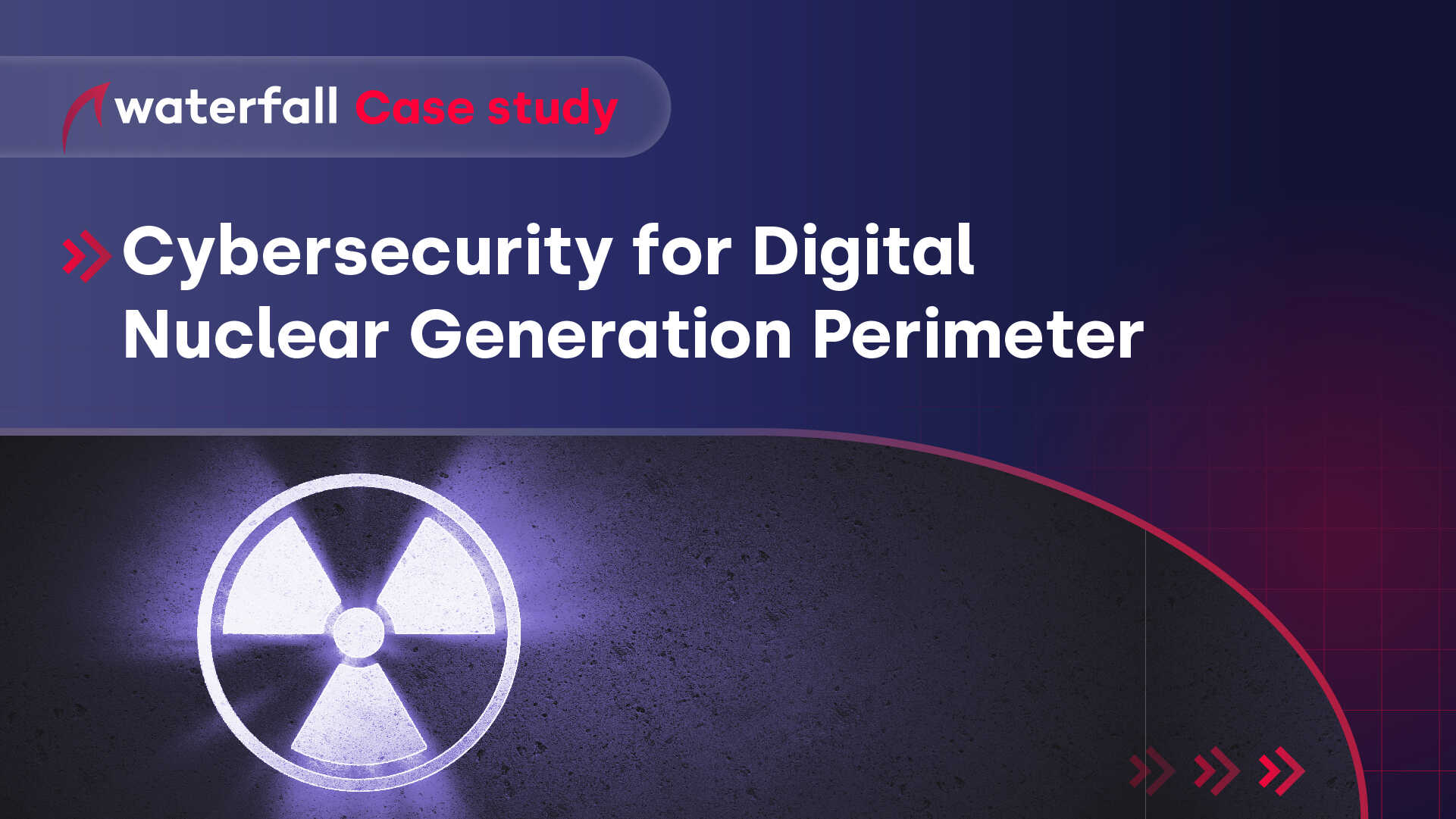Securing The Digital Nuclear Generation Perimeter
Protecting The Connected Nuclear Power Plant From Evolving Cyber Threats

Customer/ Partner:
Commercial nuclear power producer in the USA.
Customer Requirement:
To monitor nuclear generation control and safety networks in real time from enterprise networks in a way that protects control networks from cyber threats, preserves safe and reliable operations, and fully adheres to Nuclear Regulatory Commission 5.71 requirements.
Waterfall’s Unidirectional Solution:
Secure the nuclear control system network perimeter from external threats with Unidirectional Security Gateways, and enable Real-Time Enterprise Connectivity, creating a fully operational OSIsoft PI server replica.
Cyber Threats To Nuclear Power Generation
Safe reactor operations and the prevention of radiological releases, radiological sabotage and other threats to public safety are of paramount importance at all nuclear generators. Continuous and uninterrupted operations are also important, since significant power
outages can pose public safety risks as well. All nuclear generators, therefore, deploy both comprehensive physical and cyber security measures.
If malicious attackers ever gain access to a nuclear-generating unit’s Distributed Control System (DCS), sabotage of reliability-critical and even safety-critical operations is possible. The risk of such sabotage is unacceptable. Nuclear industrial security standards and regulations require operators to deploy the strongest practical measures to prevent the compromise of nuclear control and safety networks. The question is – how to achieve 100% protection from remote cyber threats?

The challenge
To secure the safe, reliable and continuous operation of nuclear control and safety networks from threats emanating from less trusted external networks, yet still provide safe, real-time access to live operations data to the enterprise network. Analog controls may be immune to cyber attacks, but modern plants use digital control systems nearly universally for steam generators, and may use digital systems for critical core control and safety systems as well. Firewalls or other IT security measures are software, and all software has vulnerabilities and so can be compromised. Nuclear generators demand much more thorough protections than software mechanisms can provide.

Waterfall solution
A Waterfall Unidirectional Security Gateway was installed between each DCS network and the enterprise network. Unidirectional Gateway software connectors replicate OSISoft PI Syslog servers from the control network to the enterprise network where enterprise clients can interact normally and bi-directionally with these replicas. A file server replication connector was also deployed, to minimize the need for removable media.

Results & benefits
100% Security: The nuclear and turbine control networks are now physically protected from any external network, fully protecting these sensitive networks from any online threats, attacks and human errors originating from external networks.
100% Visibility: Clients on the enterprise network continue to interact normally and bi-directionally with replica servers, obtaining the same data from those replicas as would have been reported by live control servers.
100% Compliance: The resulting network architecture complies with the most demanding nuclear cyber-security standards and regulations, including NRC 5.71.

Theory of Operation
Waterfall Unidirectional Security Gateways replace firewalls in industrial network environments, providing absolute protection to control systems and industrial control networks from attacks emanating from external less-trusted networks. Unidirectional Gateways contain both hardware and software components. The hardware components include a TX Module, containing a fiber-optic transmitter/ laser, and an RX Module, containing an optical receiver, but no laser. The gateway hardware can transmit information from an industrial network to an external network, but is physically incapable of propagating any virus, DOS attack, human error or any cyber attack at all back into the protected industrial network.
The Gateways enable vendor monitoring, industrial cloud services, and visibility into operations for modern enterprises and customers. Unidirectional Gateways replicate servers, emulate industrial devices and translate industrial data to cloud formats. As a result, Unidirectional Gateway technology represents a plug-and-play replacement for firewalls, without the vulnerabilities and maintenance issues that accompany firewall deployments.

Unidirectional Security Gateways Benefits:
![]() Safe integration of nuclear safety & control systems with external networks.
Safe integration of nuclear safety & control systems with external networks.
![]() Safe, continuous monitoring of critical systems.
Safe, continuous monitoring of critical systems.
![]() Compliance with even the most demanding nuclear cybersecurity regulations, standards, and best-practice guidance.
Compliance with even the most demanding nuclear cybersecurity regulations, standards, and best-practice guidance.
![]() Replacing at least one of the layers of firewalls in a defense-in-depth architecture with Unidirectional Gateways breaks the chain of malware infection and prevents pivoting attacks from less-trusted IT networks.
Replacing at least one of the layers of firewalls in a defense-in-depth architecture with Unidirectional Gateways breaks the chain of malware infection and prevents pivoting attacks from less-trusted IT networks.

Waterfall Unidirectional Solutions Simplify Regulatory Compliance
- The US NRC Regulatory Guide 5.71 Cyber Security Programs for Nuclear Facilities, and NEI 08-09 Cyber Security Plan for Nuclear
Reactors recognize and recommend stronger-than-firewall Unidirectional Gateways. - The Canadian Standards Association standard N290.7-14, Cyber Security for Nuclear Power Plants and Small Reactor Facilities recognizes the strength of unidirectional protections and requires nuclear facilities to use Unidirectional Gateways to protect the most critical cyber assets.
- In France the Agence nationale de la sécurité des systèmes d’information (ANSSI) Cybersecurity for Industrial Control Systems standard forbids firewalled connections from nuclear control networks to less-critical networks and interactive remote access from
such networks back into nuclear networks, permitting only Unidirectional Gateways in such circumstances.
Share
Trending posts
What Is Industrial Control System Software?
Lessons Learned From Incident Response – Episode 139
Stay up to date
Subscribe to our blog and receive insights straight to your inbox
